brakes AUDI TT ROADSTER 2011 Owners Manual
[x] Cancel search | Manufacturer: AUDI, Model Year: 2011, Model line: TT ROADSTER, Model: AUDI TT ROADSTER 2011Pages: 260, PDF Size: 64.11 MB
Page 17 of 260
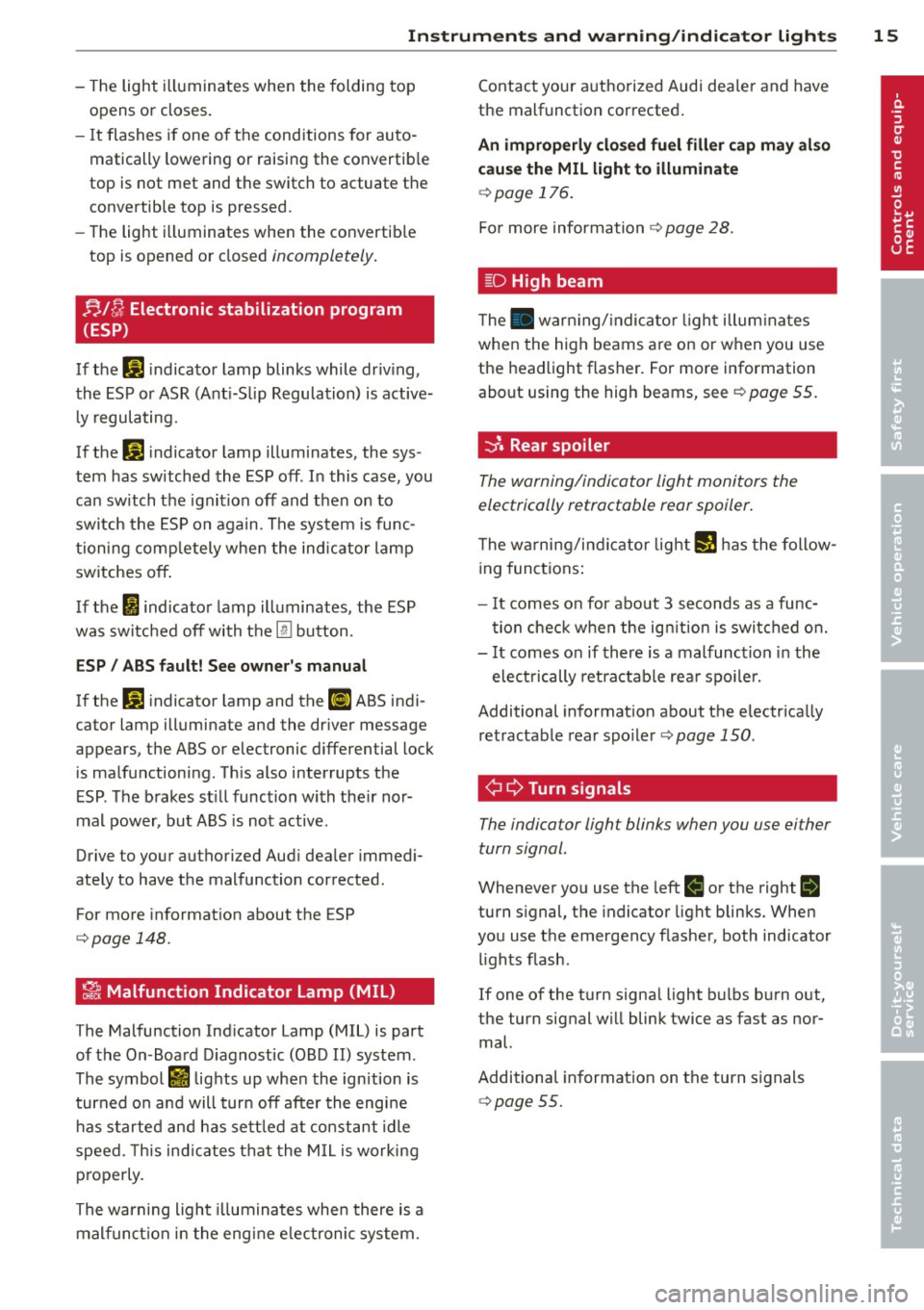
Instruments and warning/indicator lights 15
-The light illuminates when the folding top
opens or closes .
- It flashes if one of the conditions for auto
matically lowering or raising the convertib le
top is not met and the switch to actuate the convertible top is pressed.
- The light i lluminates when the convertib le
top is opened or closed
incompletely.
nl /J Electronic stabilization program
(ESP)
If the G1 i ndicator lamp blinks while dr iv ing,
the ESP or ASR (Ant i-S lip Regulation) is active
l y regulating.
If the G1 indicator lamp illuminates, the sys
tem has sw itched the ESP off. In this case, you
can switch the ignition off and then on to
switch the ESP on again. The system is func
tioning completely whe n the indicator lamp
switches off .
I f the
I indicato r lamp illuminates, the ESP
was switched off with the
[ru bu tton.
ESP/ ABS fault! See owner's manual
If the G1 indicator lamp and the ll] ABS indi
cator lamp illuminate and the dr iver message
appears, the ABS or e lectronic differential lock
is malfunctioning. This also interrupts the
E SP . The brakes st ill function with the ir nor
mal power, but ABS is not active.
Drive to your authorized Aud i dea ler immedi
ately to have the malfunction corrected .
For more information about the ESP
¢page 148.
~ Malfunction Indicator Lamp (MIL)
The Malfunction Ind icator Lamp (MIL) is part
of the On-Board Diagnostic (OBD II) system .
The symbol
rfl lights up when the ignition is
turned o n and will turn off after the engine
has started and ha s settled at constant idle
speed. This ind icates that the MIL is working
p roperly.
The warning light illuminates when there is a
malfunction in the engine e lectronic system. Contact
your authorized Audi dea ler and have
the malfunction corrected .
An improperly closed fuel filler cap may also
cause the MIL light to illuminate
¢page 176.
For more information ¢ page 28.
[D High beam
The . warn ing/ indicato r light illum inates
when the high beams are on or when you use
the headlight flasher. For more information
about using the high beams, see¢
page 55.
-::}. Rear spoiler
The warning/indicator light monitors the
electrically retractable rear spoiler .
The warning/indicator light I! has the follow
ing functions:
- It comes on for about 3 seconds as a func
tion check when the ignition is switched on.
- It comes on if there is a malfunction in the
electrically ret ra ctab le rea r spo ile r.
Additional informat ion about the e lectr ically
retractable rear spoiler ¢
page 150.
¢¢Turn signals
The indicator light blinks when you use either
turn signal.
Whenever you use the left II or the right II
turn s ignal, the indicator light blinks. When
you use the emergency flasher, both indicator
lights flash.
If one of the turn signa l light bulbs burn out,
the turn signal will blink twice as fast as nor
mal.
Additional information on the turn signals
¢page 55.
Page 19 of 260
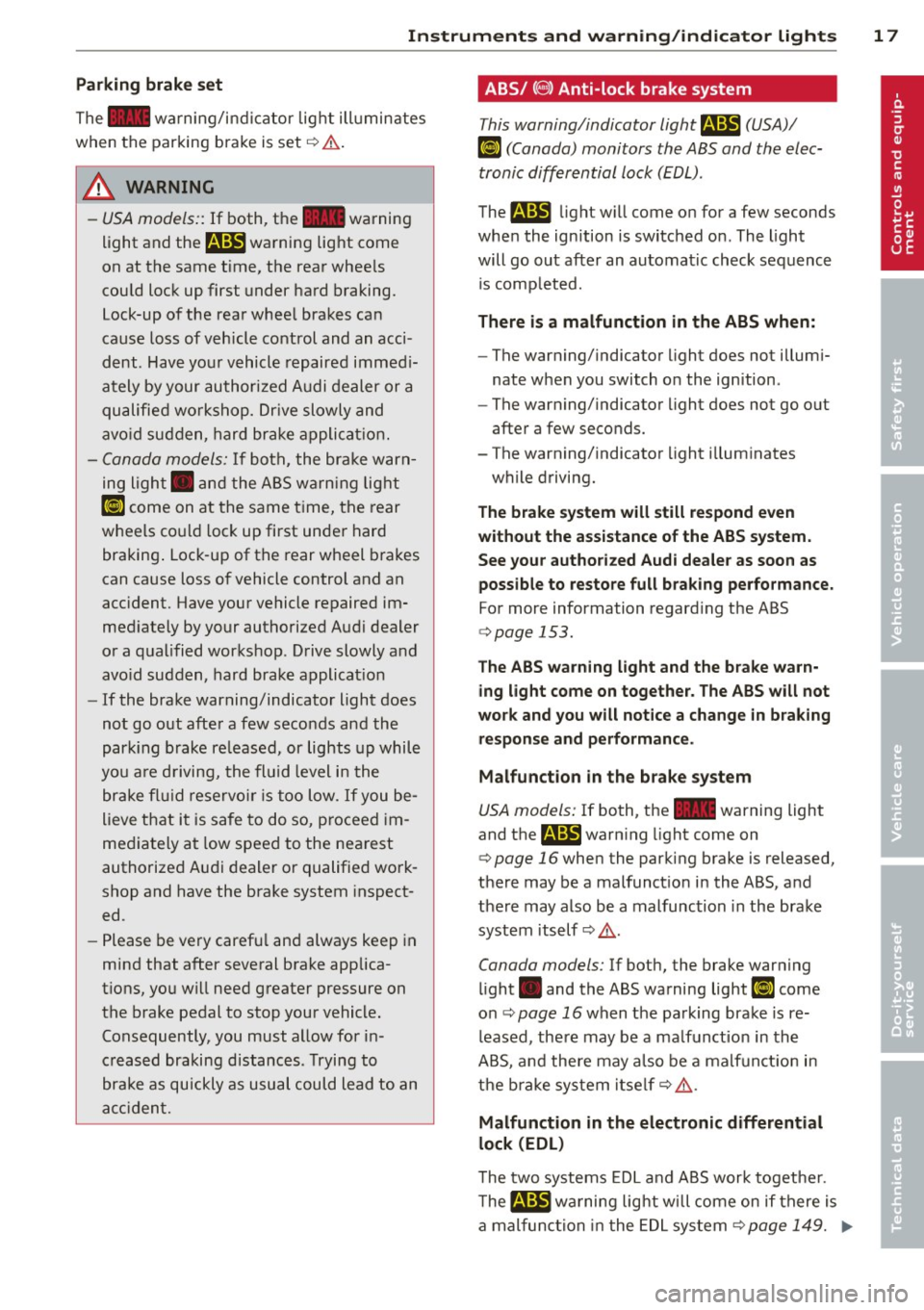
Instrument s and warnin g/indi cator ligh ts 17
Par king brak e set
The 1111 warning/indicator light ill uminates
when the parking brake is set¢
A.
,&. WARNING
,-
- USA models:: If both, the -warning
light and the
m warning light come
on at the same time, the rear whee ls
could lock up first under hard braking.
Lock-up of the rear wheel brakes can
cause loss of vehicle control and an acci
dent . Have your vehicle repaired immed i
ately by your authorized Audi dealer or a qualified wo rkshop. Dr ive slowly and
avo id sudden, hard brake applicat ion.
- Canada models: If both, the brake warn
ing light . and the ABS warning light
Ii] come on at the same time, the rear
wheels co uld lock up first unde r hard
braking . Lock-up of the rear wheel brakes
can cause loss of vehicle control and an
acc ident. Have your vehicle repaired im
med iately by your authorized Audi dealer
or a qualified workshop. Drive slowly and
avo id sudden, hard brake applicat ion
- If the brake warning/indicator light does
not go out after a few seconds and the
park ing brake re leased, or lights up while
you a re d riving, the fluid level in the
brake fl uid reservo ir is too low. If you be
lieve that it is safe to do so, p roceed im
mediately at low speed to the nearest
authorized Audi dealer or qualified wo rk
shop and have the brake system inspect
ed.
- Please be very carefu l and always keep in
mind that after several brake applica
t ions, you will need greater pressure on
the brake pedal to stop your vehicle. Consequently, you must allow for in
cr eased braking distances. Trying to
brake as quickly as usual could lead to an
acci den t.
ABS/ (8 ) Anti-lock brake system
This warning/indicator light m (USA)/
Ii] (Canada) monitors the ABS and the elec
tronic differential lock (EDL).
The m light w ill come o n for a few seconds
when the ignition is switched on. The light
will go out after an automatic check sequence
is comp leted.
There is a malfunction in the ABS when:
-The warning/indicator light does not illumi
nate when you switch o n the ignition.
- The warning/indicator light does not go out
after a few seconds.
- The warning/indicator light illuminates
while driving.
The brake system will still respond e ven
without the a ssistance of the ABS system.
See your author ized Audi de aler as soon as
possible to restore full braking performance.
For more information regard ing the ABS
¢ page 153.
The AB S warning light and the b rake w arn
ing light come on togethe r. The ABS will not
work and you will no tice a ch ange in braking
r e sponse and perform ance .
Malfunction in the brake sy stem
USA models: If both, the 1111 warning light
and the
B warn ing light come on
¢ page 16when the parking brake is released,
the re may be a malfunct ion in the ABS, and
there may also be a malfunction in the brake
system itself¢
A.
Canada models: If both, the brake warning
li ght . and the ABS warning light
(I] come
o n ¢
page 16 when the parking brake is re
l eased, there may be a ma lf u nction in the
ABS, a nd there may a lso be a malfun ct ion in
the b ra ke system itse lf¢
A .
Malfunction in th e electronic differential
lock (EDL)
T he two systems EDL and ABS work togethe r.
T he
&1!B w ar ning lig ht w ill come on if there is
a mal func tion in the EDL system¢
page 149. .,.
Page 20 of 260
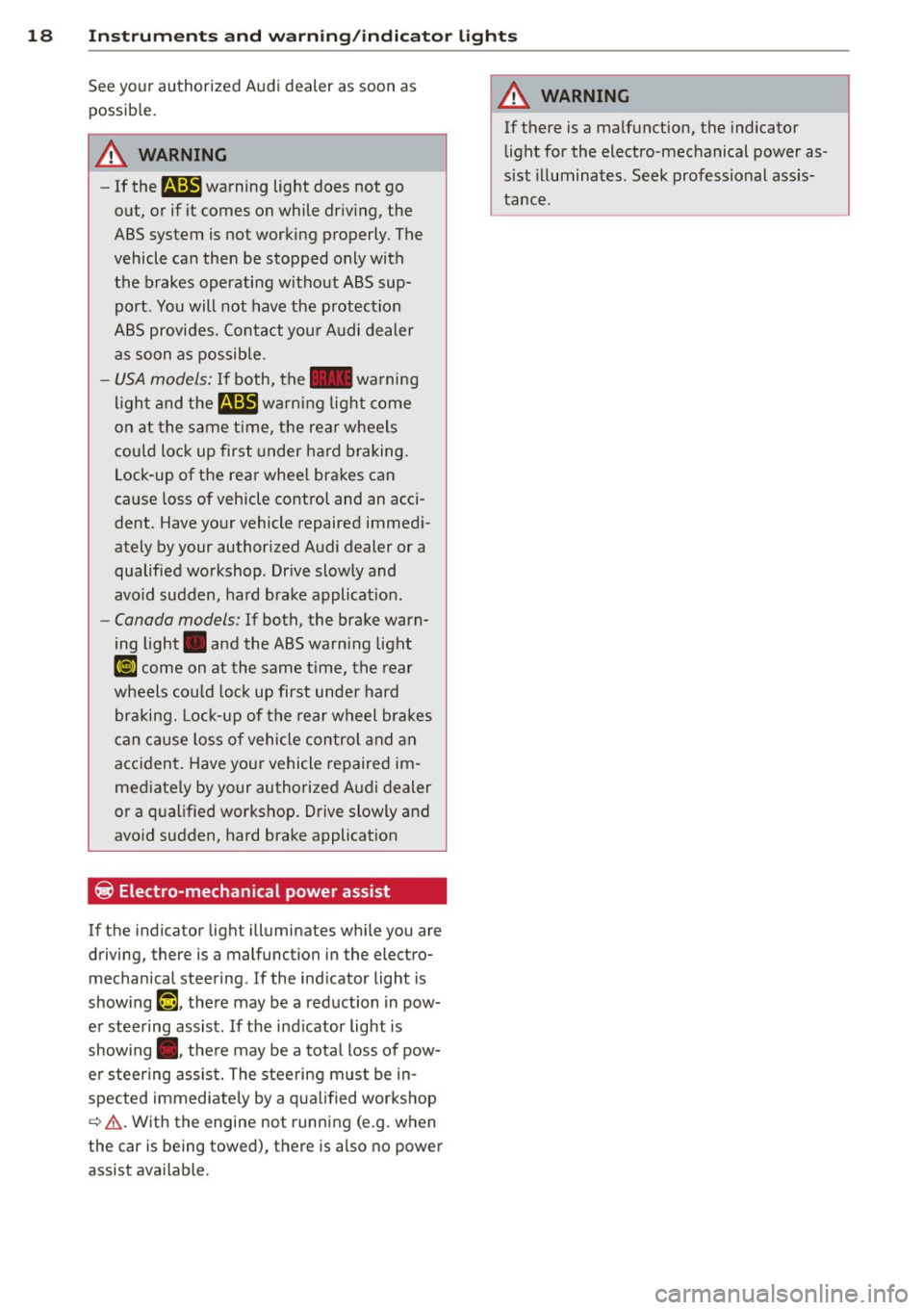
18 Instrument s and w arn ing /indic ato r light s
See your authorized Audi dealer as soon as
possible .
A WARNING
-If the B warning light does not go
out, or if it comes on while driv ing, the
ABS system is not working properly. The
vehicle can then be stopped only with
the brakes operating without ABS sup port . You will not have the protection
ABS provides. Contact you r A udi dealer
as soon as possible.
- USA models: If both, the~ warning
light and the Bwarning light come
on at the s ame t ime, the rear wheels
cou ld lock up first under hard braking.
Lock-up of the rear whee l brakes can
cause loss of vehicle control and an acci
dent. Have yo ur vehicle repaired immed i
ately by your authorized Audi dealer or a
qualified workshop. Dr ive slowly and
avo id sudden, hard brake applicat ion .
-Canada models: If both, the brake warn
ing light . and the ABS warning light
II] come on at the same t ime, the rear
wheels co uld lock up first unde r hard
braking. Loc k-up of the rear wheel b rakes
can ca use loss of vehicle control and a n
acc iden t. Have you r vehicle repaired im
me diately by your authorized Audi dealer
or a q ualified workshop. Drive slowly and
avo id sudden, hard brake applicat ion
~ Electro-mechanical power assist
If the indicator light illuminates w hile you are
driving, there is a malfunction i n the electro
mechanical steering. If the ind icator light is
show ing
E'2:'~ . the re may be a red uction in pow
e r stee ring assist. If the ind icator light is
show ing • • the re may be a tota l loss of pow
e r steering assis t. T he steering must be in
spected immediate ly by a q uali fied wor ks hop
¢ .&, .With the engine not running (e.g . when
the car is being towed), there is a lso no powe r
assist ava ilable.
A WARNING
-
If there is a ma lfunction, the indicator
light for the electro-mechanical power as
sist illuminates. Seek professional assis
tance.
Page 33 of 260

than 3 seconds and faster than 3 mph (5 km/
h).
A WARNING
-Always observe the warnings in
9 page 172, Engine compartment, be
fore opening the engine hood and check ing the brake flu id .
- Driv ing with low brake fluid is a safety
hazard! Stop the car and get professional
assistance.
- If the brake system warn ing/ indicator
light illuminates together with the ABS
warning/ind icator light, t hen the ABS
system is malfunct ion ing . The rear
wheels co uld qu ickly lock up when yo u
apply the brakes. This could lead to loss
o f control and your vehi cle could slide!
Drive carefu lly to the nearest a uthorized
Audi dealer and have the ma lfunction
corrected.
_ L Engine cooling system
A malfunction in the engine cooling system
must be repaired as soon as possible .
When the . symbol in the d isp lay flashes,
then either the eng ine coolan t
temperature is
too high, or the coo lant
level is too low. In ad
dition to the symbol, the fo llowing message
also appears in the display:
Swit ch off engine and check coolant level
"'Pull off the road and stop the vehicle.
"'T urn off t he engine.
"' Check coolant leve l
9page 185.
"'Add coolant if ne cessary¢ page 186.
"' Contin ue driving only after the eng ine cool -
ant warn ing/indicato r light goes o ut.
"' Contact your authorized Audi dea ler for as-
s istance if necessary.
If the engine coolant level is correct, then the radiator fan may be the cause of the malf unc
tion .
If the generator wa rning/ind icator light
should also illuminate ¢
page 16, then the
fan belt may be damaged.
Dr iver in formati on sys tem 3 1
A WARNING
-If your vehicle should break down for
mechanical or other reasons, park at a
safe distance from moving traffic, tu rn
off the eng in e and tu rn on the haza rd
warn ing ligh ts ¢
page 56, Emergen cy
flasher ~-
-
-Never ope n the hood if you see o r hear
s team or coola nt es caping from the en
gi ne compartmen t -you ris k being sc ald
ed . Wait unt il yo u can no longer see o r
hea r steam o r coolant escap ing.
- T he engine compa rtment o f any vehicle
is a dangerous area. Be fore you perform
a ny work i n the engine compartment,
turn off the eng ine and allow it to cool.
Follow t he warn ing stickers
9 page 172,
Engine compartment .
(D Note
Do not continue driv ing if the . sym bol
ill uminates. There is a malfunction in the
engine cooling system -you could damage
your engine.
~ Engine oil pr essure
The red engine oil pressure warning symbol
requires immediate service or repair.
If the . symbo l appears in the disp lay and
flashes, the o il pressure is too low . In add ition
to the symbol, the following message a lso ap
pears in the display:
Switch off engine and check oil le vel
"' Pull off the road an d stop the ve hicle.
"' Shu t the eng ine down.
"' Check the engine oil level¢
page 183 .
"'Contact your authorized Audi dealer for as-
sistance if necessary.
Engine oil level too low
I f the engine oil leve l is too low , top off oil to
the p roper level
¢ page 183. .,.
Page 75 of 260

Before you purchase any accessories, always
read and follow the information in
c::> page 243, Additional accessories and parts
replacement.
A WARNING
The outlet plus any appliances plugged in
to it remain functional even if the ignition
is switched off or the ignition key is re
moved. Never leave children inside the ve
hicle without supervision.
(D Note
To avo id damag ing the socket, only use
plugs that fit properly.
@ Tips
When the engine is off and accessories are still plugged in and are on, the vehicle bat
tery can still be dra ined.
Storage
General
A WARNING
- Always remove objects from the instru
ment panel. Any items not put away
cou ld slide around inside the vehicle
wh ile driving or when accelerating or
when applying the brakes or when driv ing around a corner.
-
- When you are driving make sure that
anything you may have placed in the cen
ter console or other storage locations cannot fall out into the footwells . In case
of sudden braking you would not be able
to brake or accelerate.
S ea ts a nd s to rage 73
Glove compartment
The glove compartment is illuminated and
can be locked .
i
----------- i
•
Fig . 85 Glove compartment
To open glo ve com partment
.,. Pull the handle c::> fig. 85 in the direct ion of
t he arrow pus h down lid to the fully open
position.
To clo se glove compartment
.,. Push the glove compartment lid upward un-
til the lock engages .
CD ch anger*
The CD changer for the Sound System is locat
ed in the glove compartment .
A WARNING
To reduce the risk of personal injury in an
accident or sudden stop, always keep the
glove compartment closed wh ile driving.
Storage compartment in the front seats
Applies to vehicles: with storage compartment in the
front seats
There is a fold-out storage compartment in
the front of the seats.
O pen ing
.,. Lift the handle and pull the drawer o ut.
Closin g
.. Push the drawer in completely until it latch
es.
Page 84 of 260

82 On the road
@ For the sake of the environment
To avoid unnecessary e ngine wea r and to
reduce exhaust emissions, do not let your
veh icle stand and warm up. Be ready to
drive off immediately after start ing your
veh icle . Maintain moderate speed until the
engine is comp letely warm . Remember,
the engine performs best at operating
temperature .
Stopping the engine
• Turn the ig nition key to position ©
<=> page 80, fig. 90.
&_ WARNING
- Never turn off the eng ine unti l th e vehi
cle has come to a complete stop.
- The brake booster and servotronic on ly
work when the engine is running . With
the ignition turned off, yo u have to apply
more force when steering or braking.
S ince you cannot steer and stop norma l
ly, this can lead to accidents and ser ious
injuries .
-The radiator fan can continue to run for up to 10 min utes eve n after yo u have
turned off the eng ine and rem oved the
ign iti on key. The r ad iator fa n can also
t u rn on again if th e e ngine coola nt hea ts
up because of inte nse sunlight or hea t
build -up in t he engine compartment.
(D Note
Do not stop the engi ne immed iate ly afte r
hard or extended driving . K eep the eng ine
r u nning for app rox imately two minu tes to
prevent e xcessive heat build-up .
Parking brake
Parking brake
When the parking brake is set , it prevents the
vehicle from rolling away unintentionally .
Fig. 9 1 Ce nte r co nso le: P ark ing b rak e s et
Setting the parking brake
• Pull the pa rking brake leve r all the way up.
Releasing the parking brake
• Pull the p arking brake lever up slight ly and
press the release button at the same time
<=> fig. 91 -arrow- .
• Keep the re lease button p ressed and lower
the par kin g brake <=>.&, .
If you should drive off with the parking brake
still set, a warning tone will sound and the
fol low ing will appear in the instrument clus
te r to rem ind you to re lease the par kin g
brake:
Parking brake set
The parking brake war ning comes on only af
ter you have dr iven for longer than 3 seconds
and faster than S mph (5 km/h) .
The parking brake warning light -
( U SA)/ . (CON) illuminates when the park
ing brake is set and you switch on the igni tion .
&_ WARNING
Always re lease the park ing b rake com -
plete ly. A part ially engaged brake w ill
overheat the rea r brakes, reduce their ef
fe ctive ne ss and cau se excessive wea r. This
could lead to brake f ailur e and an accident. .,..
Page 87 of 260
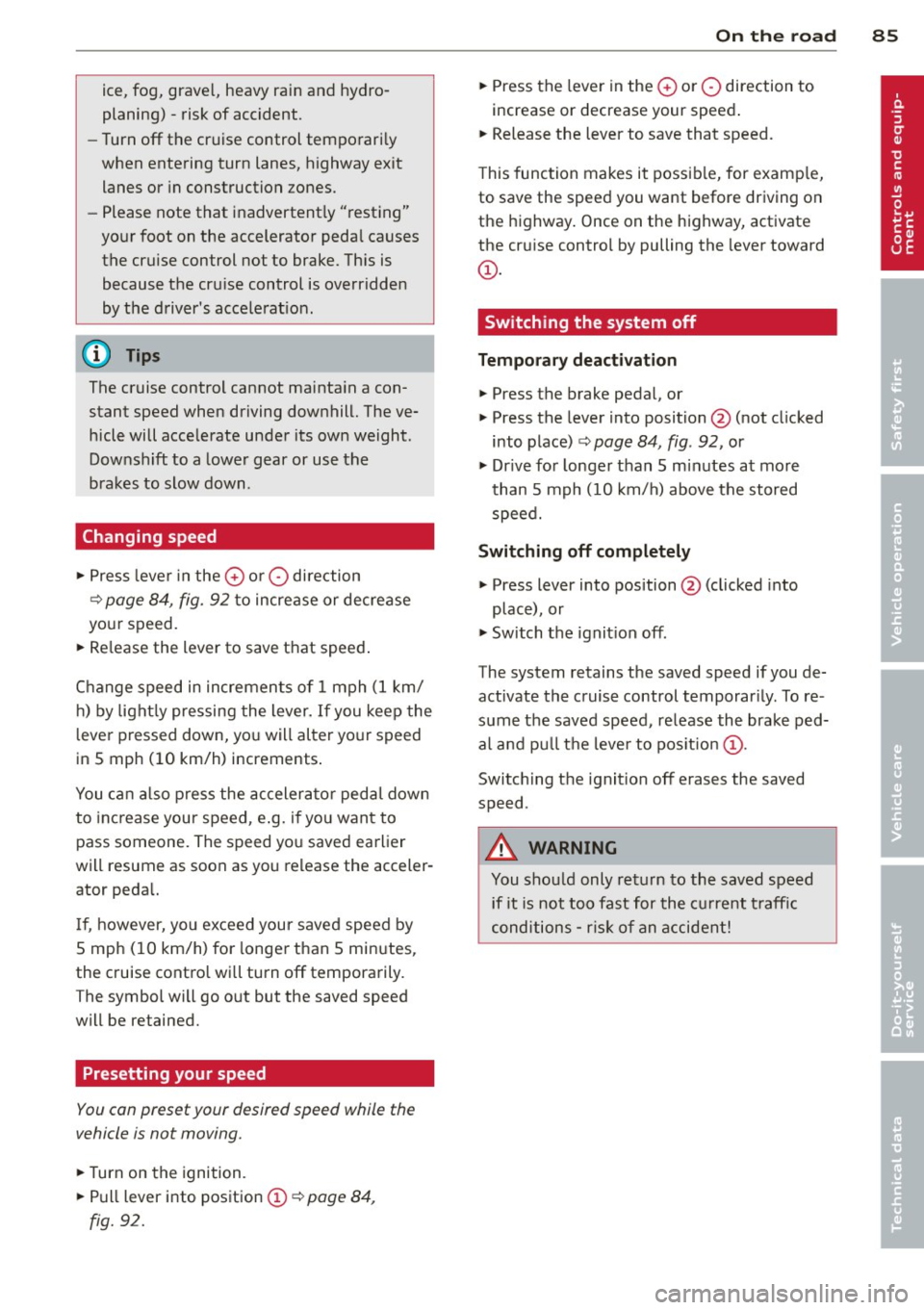
ice, fog, gravel, heavy rain and hydro
planing) -risk of accident.
- Turn off the cruise control tempo rari ly
when entering turn lanes, highway exit
lanes or in construction zones.
- Please note that inadvertent ly "rest ing"
yo ur foot on the accelerator peda l causes
the cruise control not to brake. Th is is
because the cru ise control is overridden
by the d river's acce le rat ion .
(D Tips
The cruise control cannot mainta in a con
stant speed when driving downhill. The ve
hicle will acce lerate under its own weight.
Downshift to a lower gear or use the
brakes to slow down.
Changing speed
.,. Press leve r in the 0 or O direction
¢ page 84, fig. 92 to increase or decrease
your speed.
... Re lease the lever to save that speed .
Change speed in incremen ts of 1 mph (1 km/
h) by light ly pressing the lever.
If you keep the
l ever pressed down, yo u will alter yo ur speed
in 5 mph ( 10 km/h) increments .
You ca n also press the acceler ator peda l down
to inc rease your speed, e .g. if yo u want to
pass someone. The speed yo u saved earlier
will resume as soon as you release the acceler
ator peda l.
I f, however, yo u exceed your saved speed by
S mph ( 10 km/h) for longer than 5 mi nutes,
the cruise contro l will turn off tempora rily.
T he symbol will go o ut but the saved speed
will be retained.
Presetting your speed
You can preset your desired speed while the
vehicle is not moving .
... Turn on the ignition .
... Pull lever into position
(D ~ page 84,
fig. 92.
On th e ro ad 85
... Press the lever in the 0 or O direction to
increase or decrease your speed .
... Release the lever to save that speed.
T his function makes it possib le, for e xamp le,
to save the speed you want before driving on
the highway . Once on the highway, activate
the cr uise control by pulling the lever toward
(D .
Switching the system off
Temporary deacti vation
... Press the brake pedal, or
... Press the lever into position @(not clicked
into place)
¢ page 84, fig . 92, or
... Dr ive fo r longe r than 5 m inutes at mo re
than 5 mph (10 km/h) above the stored
speed.
Switching off completely
... Press lever into position @(clicked into
place), or
... Switch the ignit ion off .
The system retains the saved speed if you de activate the cruise control temporar ily. To re
sume the saved speed, re lease the brake ped
al and pu ll th e leve r to pos it ion
(D .
Switc hing the ignit ion off erases the saved
speed .
A WARNING
You shou ld only ret urn to the saved speed
i f it is not too fast for the cu rrent traffic
conditions -ris k of an accident!
Page 92 of 260
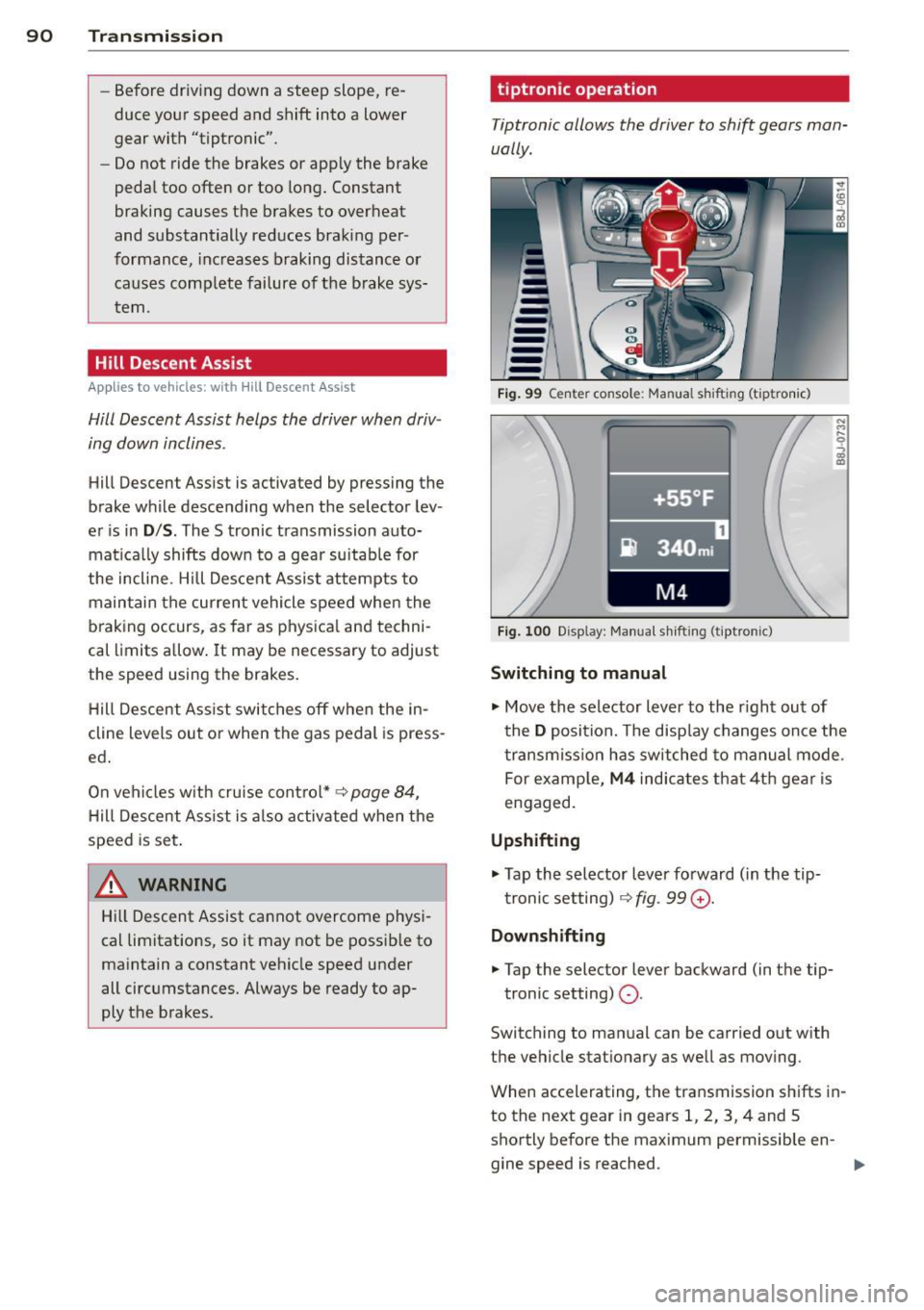
90 Transmi ssion
-Before driv ing down a steep slope, re
duce your speed and shift into a lower
g ear with "tiptronic".
- Do not ride the brakes or app ly the brake
pedal too often or too long. Constant
braking causes the brakes to overheat
and substantially reduces braking per
formance, increases b raking distance or
c a uses comp lete failure of the b rake sys
tem.
Hill Descent Assist
Ap plies to ve hicles : wit h Hill Descen t Ass is t
Hill Descent Assist helps the driver when driv
ing down inclines.
H ill Descent Ass ist is activated by pressing the
brake while descending when the selector lev
e r i s in
D/S . The S tronic transmission auto
mat ica lly shifts down to a gear suitab le for
the incline. H ill Descent Assis t attempts to
maintain the current vehicle speed whe n the
b rak ing occurs, as far as phys ica l and techni
cal limits allow . It may be necessary to adjust
the speed using the brakes .
H ill Descent Ass ist swit ches off when the in
cline levels out or when the gas pedal is press
ed .
On veh icles w ith cru ise contro l* ~
page 84,
H ill Descent Ass ist is a lso activated when the
speed is set .
L!l WARNING
Hill Descent Assist cannot overcome phys i
cal limitations, so it may not be possib le to
ma intain a constant vehicle speed under
all circumstances. Always be ready to ap
ply t he b rakes.
tiptronic operation
Tiptronic allows the driver to shift gears man
ually .
Fig . 99 Ce nter console: Manua l shi fting (tiptro nic)
Fig . 1 00 D isp lay: Ma nua l shifting (tiptron ic)
Switching to manual
.... M .... 0
~
"' Move the selector lever to the r ight out of
t he
D position. The disp lay changes once the
t ra nsm iss ion has sw itched to manual mode .
For examp le,
M4 indica tes that 4th gea r is
engaged.
Upshifting
.., Tap the selector lever fo rward ( in the tip
tronic setting)
~ fig. 99 G) .
Downshifting
... Tap the selector lever backward (in the tip-
tronic setting)
0 -
Switch ing to man ual can be carried out with
the vehicle stationary as we ll as moving .
When accelerating, the transmission sh ifts in
to the next gear in gears 1, 2, 3, 4 and 5
shortly before the maximum permissible en
gine speed is reached.
Page 150 of 260

148 Intelligent technology
Intelligent technology Notice about data
recorded by vehicle
control modules
Your vehicle is not equipped with an Event Da
ta Recorder (EDR), installed by some manu
facturers fo r the express purpose of capturing
data for retrieval after an accident or crash
event . EDR's are sometimes called "crash re
corders".
Some state laws restrict the retrieval or down
loading of data stored by EDR's that were in
stalled in a vehicle for the express purpose of
retrieving data after an accident or crash
event without the owner's consent.
A lthough your vehicle is not equipped with an
EDR, it is equipped with a number of electron
ic control modules for various vehicle systems
such as, for example, engine function, emis
sion control, as well as for the airbags and
safety belts .
These electronic control modules also record
vehicle-related data during normal vehicle op
eration for diagnostic and repair purposes.
The recording capacity of the electronic con
trol modules is limited to data (no sound is re
corded) and only a small amount of data is ac
tually recorded over a very limited period of
time and stored when a system fault or other
condition is sensed by a control unit. Some of
the data then stored may relate to vehicle
speed, direction, braking as well as restraint
system use and performance in the event of a
crash or other condition. Stored data can only
be read and downloaded with special equip
ment.
Electronic Stabilization
Program (ESP)
General
The Electronic Stability Program increases
driving stability.
With ESP, control over the vehicle is increased
in situations when the vehicle is close to the
limits of grip, such as during acceleration and
in curves . ESP reduces the risk of skidding and
improves vehicle stability under all road con
ditions.
It operates at all speeds.
The Anti -Lock Brake System (ABS), Electronic
Differential Lock (EDS) and Anti-Slip Regula
tion System (ASR) are integrated in the Elec
tronic Stability Program .
How ESP works
The ESP control unit processes the following
data from high-sensitive sensors : the rota
tional speed of the vehicle about its vertical
axis , fore-and-aft and lateral acceleration
forces, brake pressure and steering angle.
Using steering angle and vehicle speed, the
direction the driver wishes to travel is deter
mined and continuously compared with actual
vehicle behavior. If the two do not match, for
example when the vehicle begins to skid, ESP
brakes the appropriate wheel automatically.
The vehicle is stabilized again by the forces
acting on the wheel during braking. With an
oversteering vehicle (tendency for the rear end to skid out of the curve), the brake appli
cation is mainly at the front wheel on the out
side of the curve, with an understeering vehi
cle (tendency to run wide in the curve) at the
rear wheel on the inside of the curve or addi
tionally at the other wheels as needed. This
brake application is accompanied by noises.
ESP works in conjunction w ith ABS
~ page 153. If there is malfunction in the
ABS, ESP is also inoperative.
Page 153 of 260
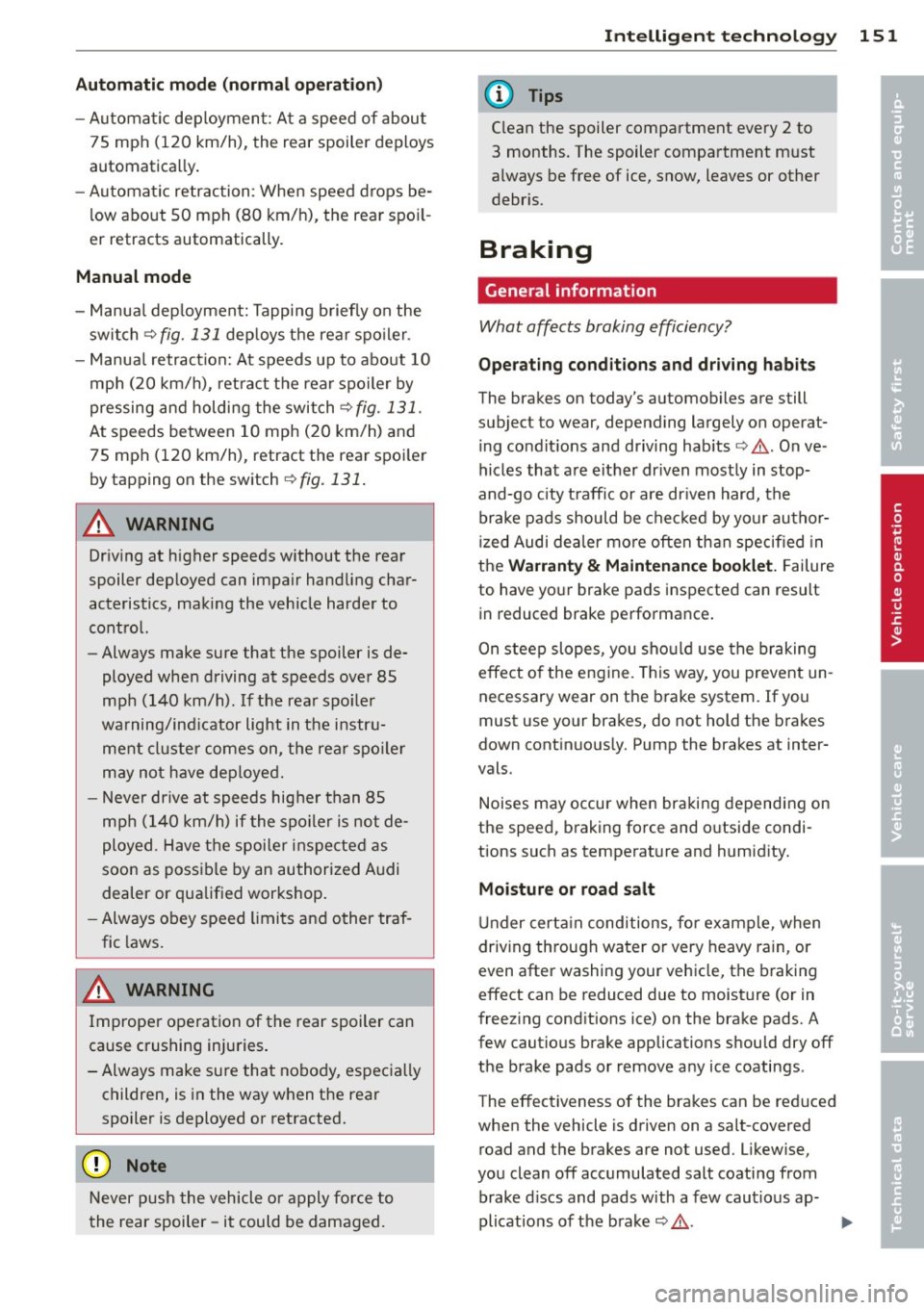
Automatic mod e (normal operat ion)
- Automatic deployment: At a speed of about
75 mph (120 km/h), the rear spoiler deploys
automatically .
- Automatic retraction: When speed drops be
low abo ut SO mph (80 km/h), the rear spoil
er retracts automatically.
Manual mode
- Manua l dep loyment: Tapping briefly on the
switch
¢ fig. 131 dep loys the rear spo iler .
- Manual retraction: At speeds up to about 10
mph (20 km/h), retract the rear spoiler by
pressing and holding the switch ¢
fig. 131.
At speeds between 10 mph (20 km/h) and
75 mph (120 km/h), retract the rear spoi ler
by tapping on the switch
¢ fig. 131 .
A WARNING
Driv ing at higher speeds w ithout the rear
spoiler dep loyed can impair handling char
acteristics, making the vehicle harder to
control.
- Always make sure that the spoiler is de·
ployed whe n driving at speeds over 85
mp h (140 km/h) . If the rea r spo ile r
wa rning/ind icator light in the instru
ment cluster comes on, the rear spo iler
may not have dep loyed.
- Never drive at speeds hig her than 85
mp h (1 40 km/h) if the spoiler is not de
ployed. Have the spoi ler inspected as
soon as possible by an authorized A udi
dealer or qualified workshop .
- Always obey speed limits and other traf
fic laws.
A WARNING
Improper operation of the rear spoiler can
cause crushing injuries .
- Always make sure that nobody, especia lly
children, is in the way when the rear
spoiler is deployed or retracted.
Q) Note
Never push the vehicle o r apply fo rce to
the rear spoiler -it could be damaged.
Int ellig ent technolog y 151
(D Tips
Clean the spoiler compa rtment every 2 to
3 months. The spoiler compartment must
a lways be free of ice, snow, leaves or other
debr is .
Braking
General information
What affects braking efficiency?
Ope rating condition s and driving h abits
The brakes on today's automobiles are still
subject to wear, depending largely on operat
ing condit ions and driving habits ¢.&, . On ve
hicles that a re either dr iven mostly in stop
and-go city t raff ic or are dr iven hard, the
brake pads should be chec ked by yo ur author
ized Audi dea ler mo re often than specified in
the
W arranty & Maintenanc e boo klet. Failure
to have your brake pads inspected can result in reduced brake performance .
On steep slopes, you should use the braking
effect o f the engine . This way, you prevent un
necessary wear on the brake system. If you
must use your brakes, do not hold the brakes
down cont in uous ly. Pump the brakes at inter
vals.
Noises may occur when braking depending on
the speed, braking force and o utside condi
tions such as temperature and humid ity.
Moisture o r ro ad s alt
U nder certa in conditions, for examp le, when
driving through water or very heavy rain , or
even after washing your vehicle, the b raking
effect can be reduced due to moist ure (or in
freezing cond itions ice) on the brake pads. A
few cautious brake applications should dry off
the brake pads or remove any ice coatings .
The effectiveness of the brakes can be reduced
when the vehicle is driven on a salt-covered road and t he brakes are not used. L ikewise,
you clean off accumulated salt coating from brake d iscs and pads with a few cautious ap-
plications of the b rake ¢ .&, .
IJJ,
•
•